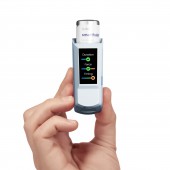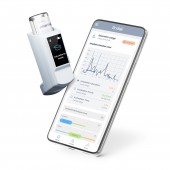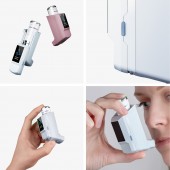
| THE AWARD |
| CATEGORIES |
| REGISTRATION |
| SUBMIT YOUR WORK |
| ENTRY INSTRUCTIONS |
| TERMS & CONDITIONS |
| PUBLICATIONS |
| DATES & FEES |
| METHODOLOGY |
| CONTACT |
| WINNERS |
| PRESS ROOM |
| GET INVOLVED |
| DESIGN PRIZE |
| DESIGN STORE |
| THE AWARD | JURY | CATEGORIES | REGISTRATION | PRESS | WINNERS | PUBLICATIONS | ENTRY INSTRUCTIONS |
Smarthaler Smart Pmdi Inhaler by Jacek Mikosz |
Home > Winners > Design #159899 >Interview |
 |
|
FS: What is the main principle, idea and inspiration behind your design?
JM: Learning a new technique, especially one that changes behavior, takes time. It’s all about feedback and visualization. Inhalation techniques are tough to master, so the device focuses on giving immediate feedback to help users get better. The tools for process of constant improvement is at the core of what we do.
FS: What has been your main focus in designing this work? Especially what did you want to achieve?
JM: Our main focus in designing this inhaler was to create a device that’s both highly functional and user-friendly. We wanted to achieve two key goals: first, to ensure the effective delivery of medication, and second, to help users develop proper inhalation techniques. By integrating an optional electronic module, we provide immediate feedback, making it easier for users to improve their technique. This dual functionality aims to enhance the overall user experience and improve health outcomes.
FS: What are your future plans for this award winning design?
JM: Ourplans include expanding its market presence and establishing collaborations with pharmaceutical companies. We also aim to promote inhaler training education, helping more users develop proper techniques for better health outcomes.
FS: How long did it take you to design this particular concept?
JM: We worked on this inhaler for almost three years.
FS: Why did you design this particular concept? Was this design commissioned or did you decide to pursuit an inspiration?
JM: The inspiration for this device came from observing close relatives struggle with conventional inhalers during asthma attacks, leading to insufficient relief despite multiple attempts. Designing a fully integrated smart inhaler was always part of our original plan for the company. However, such a complex project required the right timing, a skilled team, and significant resources to bring it to life.
FS: Is your design being produced or used by another company, or do you plan to sell or lease the production rights or do you intent to produce your work yourself?
JM: We currently manufacture with our capabilities with some help from a partners. However, we are open to licensing it if the right partner comes along for a particular market.
FS: Who is the target customer for his design?
JM: Our target customers are healthcare providers, who can use our product as a training tool both on-site and remotely. Additionally, it is a fully developed drug delivery device that meets pharmaceutical industry requirements, making it suitable for broader medical use when needed.
FS: What sets this design apart from other similar or resembling concepts?
JM: What sets this design apart from similar concepts is its modularity and flexibility. While there have been efforts to create smart inhalers before, they typically had integrated electronics that couldn't be removed or transferred. Our inhaler is modular and can function as a typical pMDI inhaler. With the Smarthaler module, it expands its capabilities. The electronics are not disposable; you can reuse them with your next inhaler when the canister is finished. This approach not only enhances functionality but also promotes sustainability.
FS: How did you come up with the name for this design? What does it mean?
JM: The name "Smarthaler" is a natural progression from the term "smart inhaler," which is becoming common in digital health. Many inhalation devices end with "haler," and since our product is an inhalation device, Smarthaler was a fitting and intuitive choice.
FS: Which design tools did you use when you were working on this project?
JM: We used several design tools while working on this project. On a daily basis, we employed 3D scanning, CAD, and CFD analysis. Additionally, we utilized analytical software and conducted numerous 3D print tests with prototypes in various technologies.
FS: What is the most unique aspect of your design?
JM: From a design perspective, is its modularity. This feature allows a standard inhaler to be transformed into a smart inhaler, addressing regulatory limitations and enabling pharmaceutical companies to enter the market with smart technologies with less risk. From a technological standpoint, our Flow Sensing technology is a standout. It allowed us to minimize the device, making it both ergonomic and easy to use.
FS: Who did you collaborate with for this design? Did you work with people with technical / specialized skills?
JM: We collaborated with specialists from various backgrounds to bring this design to life. Our solution is the result of extensive user research, clinical trials, and data collection from patients and medical professionals. It was a multidisciplinary effort, combining expertise from design, medical, IT, artificial intelligence, and pharmacokinetics fields. We integrated the device's electronics within a medical-grade plastic enclosure using precision injection molding. This approach was rigorously tested and validated through lab-based pharmacokinetic studies to ensure durability and safety.
FS: What is the role of technology in this particular design?
JM: We developed Flow Sensing Technology with an AI algorithm that measures the flow during inhalation using numerous sensors, all without requiring difficult calibration. This system also reviews each inhalation in terms of the user's technique. This technology enabled us to create a device that is easy to use and provides instant feedback on the inhaler screen about the performed inhalation.
FS: Is your design influenced by data or analytical research in any way? What kind of research did you conduct for making this design?
JM: We condudcted research that aimed to refine pmdi inhaler experience, employing a mixed-method approach. We conducted medical experiments, and observational studies complemented by desk research to gather base data and validated in clinical trials, and lab tests. Using custom measurement setups and digital tools, we gathered data from a diverse group of patients and healthcare professionals. The findings emphasized the need for modular, intuitive inhalers that improve user inhaler technique and treatment efficacy.
FS: What are some of the challenges you faced during the design/realization of your concept?
JM: The primary challenge was integrating advanced technology into a design as familiar as a traditional pMDI inhaler, ensuring it was approachable yet innovative. Our objective was for users to adopt this advanced inhaler as naturally as they would their standard one, but with added functionalities for a richer experience. Developing a modular design was crucial to allow for the sustainable use of electronic components, enabling users to update or replace parts without discarding the entire device.
FS: How did you decide to submit your design to an international design competition?
JM: We wanted our work to be evaluated by other design specialists. We're open to feedback and eager to learn from each comment, as it helps us improve and grow.
FS: What did you learn or how did you improve yourself during the designing of this work?
JM: We significantly expanded our capabilities. We moved from designing sensors for inhalers to creating fully integrated drug delivery devices. This process involved going through all the necessary stages to develop a product ready for market entry. It taught us a lot about the intricacies of product development, regulatory requirements, and the importance of user feedback.
FS: Thank you for providing us with this opportunity to interview you.
A' Design Award and Competitions grants rights to press members and bloggers to use parts of this interview. This interview is provided as it is; DesignPRWire and A' Design Award and Competitions cannot be held responsible for the answers given by participating designers.
| SOCIAL |
| + Add to Likes / Favorites | Send to My Email | Comment | View Press-Release |





